Typewriter
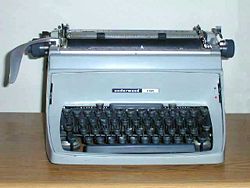
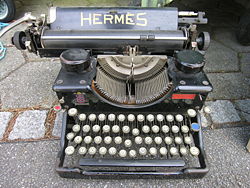
A typewriter is a mechanical or electromechanical device with a set of "keys" that, when pressed, cause characters to be printed on a medium, usually paper. For much of the 20th century, typewriters were indispensable tools for many professional writers and in business offices. By the end of the 1980s, word processor applications on personal computers had largely replaced the tasks previously accomplished with typewriters. Typewriters, however, remain popular in the developing world and among some niche markets, and for some office tasks.
Notable typewriter manufacturer companies have included E. Remington and Sons, IBM, Imperial typewriters, Oliver Typewriter Company, Olivetti, Royal Typewriter Company, Smith Corona, and Underwood Typewriter Company.
History
Early innovations

No single person or nation can be credited with the invention of the typewriter. As with the light bulb, automobile, telephone, and telegraph, a number of people contributed insights and inventions that eventually resulted in commercially successful instruments. In fact, historians have estimated that some form of typewriter was invented 52 times as tinkerers tried to come up with a workable design.[1]
In 1714, Henry Mill obtained a patent in Britain for a machine that, from the patent, appears to have been similar to a typewriter, but nothing further is known.[2] Other early developers of typewriting machines include Pellegrino Turri, who also invented carbon paper. Many of these early machines, including Turri's, were developed to enable the blind to write.
In 1829, William Austin Burt patented a machine called the "Typographer." Like many other early machines, it is sometimes listed as the "first typewriter"; the Science Museum (London) describes it merely as "the first writing mechanism whose invention was documented," but even that claim may be excessive, since Turri's machine is well known.[3] Even in the hands of its inventor, it was slower than handwriting. Burt and his promoter John D. Sheldon never found a buyer for the patent, and it was never commercially produced. Because it used a dial to select each character rather than keys, it was called an "index typewriter" rather than a "keyboard typewriter," if it is to be considered a typewriter at all.
By the mid-1800s, the increasing pace of business communication was creating a need for mechanization of the writing process. Stenographers and telegraphers could take down information at rates up to 130 words per minute, but a writer with a pen was limited to about 30 words per minute (the 1853 speed record).[4] From 1829 to 1870, many printing or typing machines were patented by inventors in Europe and America, but none went into commercial production.
Charles Thurber developed multiple patents; his first, in 1843, was developed as an aid to the blind. See Charles Thurber's 1845 Chirographer, as an example. In 1855, the Italian Giuseppe Ravizza created a prototype typewriter called "Cembalo scrivano o macchina da scrivere a tasti". It was an advanced machine that let the user see the writing as it was typed. In 1861, Father Francisco João de Azevedo, a Brazilian priest, made his own typewriter with basic materials and tools, such as wood and knives. D. Pedro I, the Brazilian emperor, in that same year, presented a gold medal to Father Azevedo for this invention. Many Brazilian people as well as the Brazilian federal government recognize Fr. Azevedo as the real inventor of the typewriter, a claim that has been the subject of some controversy.[5] In 1865, American John Pratt built a machine called the Pterotype which appeared in an 1867 Scientific American article and inspired other inventors. Between 1864 and 1867 Peter Mitterhofer, a carpenter from South Tyrol (then Austria) developed several models of a typewriter and a fully functioning prototype in 1867.
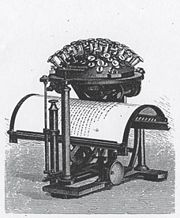
In 1865, Rev. Rasmus Malling-Hansen of Denmark invented the Hansen Writing Ball, which went into commercial production in 1870 and was the first commercially sold typewriter. It was a success in Europe and was reported as being used in offices in London as late as 1909.[6] In addition, Malling-Hansen used a solenoid escapement to return the carriage on some of his models and was a responsible candidate for the first "electric" typewriter. From the book Hvem er Skrivekuglens Opfinder?, written by Malling-Hansen's daughter, Johanne Agerskov, we know that, in 1865, Malling-Hansen made a porcelain model of the keyboard of his writing ball and experimented with different placements of the letters to achieve the fastest writing speed. Malling-Hansen placed the letters on short pistons that went directly through the ball and down to the paper. This, together with placement of the letters so that the fastest writing fingers struck the most frequently used letters, made the Hansen Writing Ball the first typewriter to produce text substantially faster than a person could write by hand.
Malling-Hansen developed his typewriter further through the 1870s and 1880s and made many improvements, but the writing head remained the same. On the first model of the writing ball from 1870, the paper was attached to a cylinder inside a wooden box. In 1874, the cylinder was replaced by a carriage, moving beneath the writing head. Then, in 1875, the well-known tall model was patented and it was the first of the writing balls that worked without electricity. Malling-Hansen attended the world exhibitions in Vienna in 1873 and Paris in 1878. At both exhibitions, he received the first-prize medals for his invention.[7][8][9]
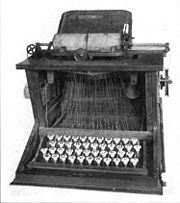
The first typewriter to be commercially successful was invented in 1867 by Christopher Sholes,[1] Carlos Glidden and Samuel W. Soule in Milwaukee, Wisconsin. Sholes soon disowned the machine and refused to use or even to recommend it.[1] The patent (US 79,265) was sold for $12,000 to Densmore and Yost, who made an agreement with E. Remington and Sons (then famous as a manufacturer of sewing machines) to commercialize the machine as the Sholes and Glidden Type-Writer, which was the origin of the term typewriter. Remington started production of its first typewriter on March 1, 1873, in Ilion, New York. It had a QWERTY keyboard layout, which because of the machine's success slowly was adopted by other typewriter manufacturers.
The ability to view what is typed, as it is typed, is taken for granted today. In most early keyboard typewriters, however, the typebars struck upward against the bottom of the platen. Thus, what was typed was not visible until the typing of subsequent lines caused it to scroll into view. The difficulty with any other arrangement was ensuring that the typebars fell back into place reliably when the key was released. This was eventually achieved with various ingenious mechanical designs and so-called "visible typewriters", such as the Oliver typewriter, were introduced in 1895. Surprisingly, the older style continued in production to as late as 1915.
Standardization
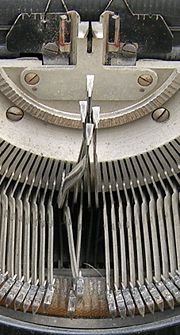
By about 1910, the "manual" or "mechanical" typewriter had reached a somewhat standardized design. There were minor variations from one manufacturer to another, but most typewriters followed the concept that each key was attached to a typebar that had the corresponding letter molded, in reverse, into its striking head. To have letters typed in exact location, the typebar was guided all its way till the ribbon by segment. When a key was struck briskly and firmly, the typebar hit a ribbon (usually made of inked fabric) stretched in front of a cylindrical platen that moved back and forth. The paper was rolled around by the typewriter's platen, which was then rotated by the "carriage return" lever (at the far left) into position for each new line of text.
A significant innovation was the Shift key. This key physically "shifted" either the basket of typebars, in which case the typewriter is described as "basket shift", or the the whole carriage, in which case the typewriter is described as "carriage shift". This means that a different portion of the bar would come in contact with the ribbon/platen. The result is that each typebar could type two different characters, cutting the number of keys and typebars in half (and simplifying the internal mechanisms considerably). The obvious use for this was to allow letter keys to type both upper and lower case, but normally the number keys were also duplexed, allowing access to special symbols such as percent (%) and ampersand (&). With the Shift key, manufacturing costs (and therefore purchase price) were greatly reduced, and typist operation was simplified; both factors contributed greatly to mass adoption of the technology.
However, because the Shift key required more force to push (its mechanism was moving a much larger mass than other keys), and was operated by the "pinky" finger (normally the weakest finger on the hand), it was difficult to hold the Shift down for more than two or three consecutive strokes. The "Shift Lock" key (the precursor to the modern Caps Lock) allowed the shift operation to be maintained indefinitely. Unlike the today's Caps Lock, however, the Shift Lock was a two-key operation: Shift would be held down, and the Shift Lock (normally directly above) would be pressed simultaneously, triggering a simple lock mechanism. To unlock, Shift was tapped again, releasing both keys and unshifting the basket.
Some ribbons were inked in black and red stripes, each being half the width and the entire length of the ribbon. A lever on most machines allowed switching between colors, which was useful for bookkeeping entries where negative amounts had to be in red.
In the early part of the 20th century, a "silent" typewriter was marketed under the name "Noiseless". It was developed by Wellington Parker Kidder and the first model was marketed by the Noiseless Typewriter Company in 1917. An agreement with Remington in 1924 saw production transferred to Remington, and a further agreement in 1929 allowed Underwood to produce it as well.[10] It failed, leading some observers to the conclusion that the clickety-clack of the typical typewriter was a consumer preference.[1] A more likely reason is that the claims of silent operation were simply untrue.
In a conventional typewriter the type bars are decelerated at the end of their travel simply by impacting upon the ribbon and paper. So-called "noiseless" typewriters have a complex lever mechanism that decelerates the typebar mechanically and then presses it against the ribbon and paper[10] in an attempt to render the process less noisy. It was not particularly successful; it certainly reduced the high-frequency content of the sound, rendering it more of a "clunk" than a "clack" and arguably less intrusive, but the grandiose claims of the advertising - such as "a machine that can be operated a few feet away from your desk - And not be heard" - were entirely without foundation.
Electric designs
Although electric typewriters would not achieve widespread popularity until nearly a century later, the basic groundwork for the electric typewriter was laid by the Universal Stock Ticker, invented by Thomas Edison in 1870. This device remotely printed letters and numbers on a stream of paper tape from input generated by a specially designed typewriter at the other end of a telegraph line.
The first electric typewriter was produced by the Blickensderfer Manufacturing Company, of Stamford, Connecticut, in 1902. Like the manual Blickensderfer typewriters it used a cylindrical typewheel rather than individual typebars. It was not a commercial success, which may have been due to the fact that at the time electricity had not been standardized and current differed from city to city. The next step in the development of the electric typewriter came in 1909, when Charles and Howard Krum file a patent for the first practical teletype machine. The Krums' machine also used a typewheel rather than individual typebars. While innovative, neither of these machines reached business or personal consumers.
James Fields Smathers of Kansas City invented what is considered the first practical power-operated typewriter in 1914. In 1920, after returning from Army service, he produced a successful model and in 1923 turned it over to the Northeast Electric Company of Rochester for development. Northeast was interested in finding new markets for their electric motors and developed Smathers' design so that it could be marketed to typewriter manufacturers, and from 1925 Remington Electric typewriters were produced powered by Northeast's motors.
After some 2,500 electric typewriters had been produced, Northeast asked Remington for a firm contract for the next batch. However, Remington was engaged in merger talks which would eventually result in the creation of Remington Rand and no executives were willing to commit to a firm order. Northeast instead decided to enter the typewriter business for itself, and in 1929 produced the first Electromatic Typewriter.
In 1928, General Motors' Delco division purchased Northeast Electric, and the typewriter business was spun off as the Electromatic Typewriters, Inc. In 1933, Electromatic was acquired by IBM, which then spent $1 million on a redesign of the Electromatic Typewriter, launching the IBM Electric Typewriter Model 01 in 1935. By 1958 IBM was deriving 8% of its revenue from the sale of electric typewriters.
Electrical typewriter designs removed the direct mechanical connection between the keys and the element that struck the paper. Not to be confused with later electronic typewriters, electric typewriters contained only a single electrical component: the motor. Where the keystroke had previously moved a typebar directly, now it engaged mechanical linkages that directed mechanical power from the motor into the typebar.
IBM and Remington Rand electric typewriters were the leading models until IBM introduced the IBM Selectric typewriter in 1961, which replaced the typebars with a spherical element (or typeball) slightly larger than a golf ball, with reverse-image letters molded into its surface. The Selectric used a system of latches, metal tapes, and pulleys driven by an electric motor to rotate the ball into the correct position and then strike it against the ribbon and platen. The typeball moved laterally in front of the paper instead of the former platen-carrying carriage moving the paper across a stationary print position.

The typeball design had many advantages, especially the elimination of "jams" (when more than one key was struck at once and the typebars became entangled) and in the ability to change the typeball, allowing multiple fonts to be used in a single document. Selectric mechanisms were widely incorporated into computer terminals in the 1960s, as they possessed obvious advantages:
- The mechanism was reasonably fast and jam-free
- It could produce high quality output compared to competitors such as Teletype machines
- It could be initiated by a short, low-force mechanical action
- It did not require the movement of a heavy "type basket" to shift between lower- and upper-case
- It did not require the platen roller assembly to move from side to side (a problem with continuous-feed paper)
The IBM 2741 terminal was a popular example of a Selectric-based computer terminal, and similar mechanisms were employed as the console devices for many IBM System/360 computers. These mechanisms used "ruggedized" designs compared to those in standard commercial typewriters.
IBM also gained an advantage by marketing more heavily to schools than did Remington, with the idea that students who learned to type on an IBM Electric would later choose IBM typewriters over the competition in the workplace as businesses replaced their old manual models.
Later models of IBM Executives and Selectrics replaced inked fabric ribbons with "carbon film" ribbons that had a dry black or colored powder on a clear plastic tape. These could be used only once, but later models used a cartridge that was simple to replace. A side effect of this technology was that the text typed on the machine could be easily read from the used ribbon, raising issues where the machines were used for preparing classified documents (ribbons had to be accounted for to ensure that typists didn't carry them from the facility).[11] In fact, a document reconstructed from a used carbon ribbon was the key to solving a crime in an episode of Columbo called "Now You See Him".

A variation known as "Correcting Selectrics" introduced a correction feature, where a sticky tape in front of the print ribbon could remove the black-powdered image of a typed character, eliminating the need for white dab-on paint or hard erasers that could tear the paper. These machines also introduced selectable "pitch" so that the typewriter could be switched between pica (10 characters per inch) and elite (12 per inch), even within one document. Even so, all Selectrics were monospaced—each character and letterspace was allotted the same width on the page, from a capital "W" to a period. Although IBM had produced a successful typebar-based machine with three levels of proportional spacing, called the IBM Executive, no proportionally spaced Selectric office typewriter was ever introduced. There were, however, two other machines with fully proportional spacing: the expensive Selectric Composer, which was capable of right-margin justification and was considered a typesetting machine rather than a typewriter; and the more reasonably priced IBM Electronic Typewriter 50, which was capable of proportional spacing but not right-justifying. By 1970, as offset printing began to replace letterpress printing, the Composer would be adapted as the output unit for a typesetting system. The system included a computer-driven input station to capture the key strokes on magnetic tape and insert the operator's format commands, and a Composer unit to read the tape and produce the formatted text for photo reproduction.
The final major development of the typewriter was the "electronic" typewriter. Most of these replaced the typeball with a daisy wheel mechanism (a disk with the letters molded on the outside edge of the "petals"). A plastic daisy-wheel was much simpler and cheaper than the typeball but also wore out more easily. Some electronic typewriters were in essence dedicated word processors with internal memory and cartridge or diskette external memory-storage devices. Unlike the Selectrics and earlier models, these really were "electronic" and relied on integrated circuits and multiple electromechanical components.
Due to falling sales, IBM sold its typewriter division in 1990 to Lexmark.
Computer-typewriter hybrids
Towards the end of the commercial popularity of typewriters in the 1980s, a number of hybrid designs combining features of computer printers and typewriters were introduced.
These typically incorporated keyboards from existing models of typewriters and the printing mechanism of dot-matrix printers. The generation of teletypes with impact pin-based printing engines was not adequate for the demanding quality required for typed output. Newly developed, thermal transfer technologies used in thermal label printers had become technically feasible for typewriters.
IBM produced a series of typewriters called Thermotronic with letter-quality output and correcting tape along with printers tagged Quietwriter. Brother extended the life of their typewriter product line with similar products. DEC meanwhile had the DECwriter.
The development of these proprietary printing engines provided the vendors with exclusive markets in consumable ribbons and the possibility to use standardised printing engines with varying degrees of electronic and software sophistication to develop product lines.
The increasing dominance of personal computers, the introduction of low-cost, truly high-quality, laser and inkjet printer technologies, and the pervasive use of web publishing, email and other electronic communication techniques have largely replaced typewriters.
Legacy
Keyboard layouts: "QWERTY" and others
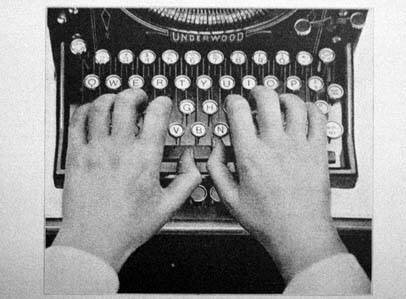
The 1874 Sholes & Glidden typewriters established the "QWERTY" layout for the letter keys. During the period in which Sholes and his colleagues were experimenting with this invention, other keyboard arrangements were apparently tried, but these are poorly documented.[12] The near-alphabetical sequence on the "home row" of the QWERTY layout (a-s-d-f-g-h-j-k-l) demonstrates that a straightforward alphabetical arrangement was the original starting point.[13] The QWERTY layout of keys has become the de facto standard for English-language typewriter and computer keyboards. Other languages written in the Latin alphabet sometimes use variants of the QWERTY layouts, such as the French AZERTY, the Italian QZERTY, and the German QWERTZ layouts.
The QWERTY layout is not the most efficient layout possible, since it requires a touch-typist to move his or her fingers between rows to type the most common letters. A popular story suggests that it was designed and used for early typewriters exactly because it was so inefficient; it slowed a typist down so as to reduce the frequency of the typewriter's typebars wedging together and jamming the machine. Another story is that the QWERTY layout allowed early typewriter salesmen to impress their customers by being able to easily type out the example word "typewriter" without having learnt the full keyboard layout, because "typewriter" can be spelled purely on the top row of the keyboard. The most likely explanation is that the QWERTY arrangement was designed to reduce the likelihood of internal clashing by placing commonly used combinations of letters farther from each other inside the machine.[14][15] This allowed the user to type faster without jamming. Unfortunately, no definitive explanation for the QWERTY keyboard has been found, and typewriter aficionados continue to debate the issue.
A number of radically different layouts such as Dvorak have been proposed to reduce the perceived inefficiencies of QWERTY, but none have been able to displace the QWERTY layout; their proponents claim considerable advantages, but so far none has been widely used. The Blickensderfer typewriter with its DHIATENSOR layout may have possibly been the first attempt at optimizing the keyboard layout for efficiency advantages.
Many old typewriters do not contain a separate key for the numeral 1 or the exclamation point, and some even older ones also lack the numeral zero. Typists who learned on these machines learned the habit of using the lowercase letter l for the digit 1, and the uppercase O for the zero. The exclamation point was a three-stroke combination of an apostrophe, a backspace, and a period. These characters were omitted to simplify design and reduce manufacturing and maintenance costs; they were chosen specifically because they were "redundant" and could be recreated using other keys. On modern keyboards, the exclamation point is the shifted character on the 1 key, a direct result of the heritage that these were the last characters to become "standard" on keyboards. Holding the spacebar pressed down usually suspended the carriage advance mechanism, allowing to type multiple symbols on a single location. The ¢ symbol (meaning cents) was located above the number 6 on old typewriters. Modern keyboards now use ^ above the 6.

Many non-Latin alphabets have keyboard layouts that have nothing to do with QWERTY. The Russian layout, for instance, puts the common trigrams ыва, про, and ить on adjacent keys so that they can be typed by rolling the fingers. The Greek layout, on the other hand, is a variant of QWERTY.
Typewriters were also made for East Asian languages with thousands of letters, such as Chinese or Japanese. [3] [4] They were not easy to operate, but professional typists used them for a long time until the development of electronic word processors in the 1980s.
Computer jargon
Several words of the 'typewriter age' have survived into the personal computer era. Examples include:
- backspace – a keystroke that moved the cursor backwards one position (on a physical platen, this is the exact opposite of the space key), for the purpose of overtyping a character. This could be for combining characters (e.g. an apostrophe, backspace, and period make an exclamation point - a character missing on some early typewriters), or for correction such as with the correcting tape that developed later.
- carriage return (CR) – indicating an end of line and return to the first column of text.
- carbon copy – now in its abbreviated form "CC" designating copies of email messages (with no carbon paper involved).
- cursor – a marker used to indicate where the next character will be printed.
- cut and paste – taking text, a table, or an image and pasting it into a document; originally used when such compound documents were created using manual paste up techniques.
- line feed (LF), aka 'newline' – standing for moving the cursor to the next on-screen line of text in a word processor document.
- Shift – Today being a simple function key to make uppercase letters, different symbols, and whatnot, but in the age of typewriters it meant literally shifting the print carriage to allow a different stamp (such as a D instead of a d) to press into the ribbon and print on a page.
- tty, short for teletypewriter, is used in Unix-like operating systems to designate a given "terminal".
Effect on culture
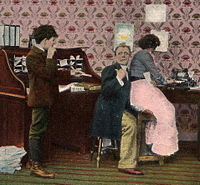
When Remington first started marketing typewriters, the company assumed the machine would not be used for composing but for transcribing dictation, and that the person typing would be a woman. Flowers were printed on the casing of early models to make the machine seem more comfortable for women to use. In the United States, women often started in the professional workforce as typists; in fact, according to the 1910 U.S. census, 81 percent of typists were female. With more women brought out of the home and into offices, there was some concern about the effects this would have on the morals of society. The "typewriter girl" became part of the iconography of the early-twentieth-century office. The "Tijuana bibles" — adult comic books produced in Mexico for the American market, starting in the 1930s — often featured women typists. In one panel, a businessman in a three-piece suit, ogling his secretary’s thigh, says, "Miss Higby, are you ready for—ahem!—er—dictation?"[1]
The famous quote by Marcus Glenn, "Live by the typewriter, die by the typewriter!" also dates from this period.
Correction methods
According to the standards taught in secretarial schools in the mid-1900s, a business letter was supposed to have no mistakes and no visible corrections. Accuracy was prized as much as speed. Indeed, typing speeds, as scored in proficiency tests and typewriting speed competitions, included a deduction of ten words for every mistake. Corrections were, of course, necessary, and several methods were used.
The traditional method involved the use of a special typewriter eraser made of hard rubber that contained an abrasive material. It was in the shape of a thin, flat, disk, approximately 2 in (50 mm) in diameter by 1/8 in (3 mm) thick, allowing for erasure of individual typed letters. Business letters were typed on heavyweight, high-rag-content bond paper, not merely to provide a luxurious appearance, but also to stand up to erasure. Typewriter erasers were often equipped with a brush for clearing eraser crumbs and paper dust, and using the brush properly was an important element of typewriting skill (if erasure detritus fell into the typewriter, a small buildup could cause the typebars to jam in their narrow supporting grooves).
Erasing a set of carbon copies was particularly difficult, and called for the use of a device called an eraser shield to prevent the pressure of erasure on the upper copies from producing carbon smudges on the lower copies.
Paper companies produced a special form of typewriter paper called erasable bond (for example, Eaton's Corrasable Bond). This incorporated a thin layer of material that prevented ink from penetrating and was relatively soft and easy to remove from the page. An ordinary soft pencil eraser could quickly produce perfect erasures on this kind of paper. However, the same characteristics that made the paper erasable made the characters subject to smudging due to ordinary friction and deliberate alteration after the fact, making it unacceptable for business correspondence, contracts, or any archival use.
In the 1950s and 1960s, correction fluid made its appearance, under brand names such as Liquid Paper, Wite-Out and Tipp-Ex. This was a kind of opaque, white, fast-drying paint that produced a fresh white surface onto which a correction could be retyped. However, when held to the light, the covered-up characters were visible, as was the patch of dry correction fluid (which was never perfectly flat, and never a perfect match for the color, texture, and luster of the surrounding paper). The standard trick for solving this problem was photocopying the corrected page, but this was possible only with high quality photocopiers.
Dry correction products (such as correction paper) under brand names such as "Ko-Rec-Type" were introduced in the 1970s and functioned like white carbon paper. A strip of the product was placed over the letters needing correction, and the incorrect letters were retyped, causing the black character to be overstruck with a white overcoat. Similar material was soon incorporated in carbon-film electric typewriter ribbons; like the traditional two-color black-and-red inked ribbon common on manual typewriters, a black and white correcting ribbon became commonplace on electric typewriters.
The pinnacle of this kind of technology was the IBM Electronic Typewriter series. These machines, and similar products from other manufacturers, used a separate correction ribbon and a character memory. With a single keystroke, the typewriter was capable of automatically reversing and overstriking the previous characters with minimal marring of the paper. White cover-up or plastic lift-off correction ribbons are used with fabric ink or carbon film typing ribbons, respectively.
Typing speed records and speed contests
During the 1920s through 1940s, typing speed was an important secretarial qualification and typing contests were popular and often publicized by typewriter companies as promotional tools.
As of 2005, Barbara Blackburn was the fastest English language typist in the world, according to The Guinness Book of World Records. Using the Dvorak Simplified Keyboard, she has maintained 150 words per minute (wpm) for 50 minutes, and 170 wpm for shorter periods. She has been clocked at a peak speed of 212 wpm. Blackburn, who failed her typing class in high school, first encountered the Dvorak keyboard in 1938, quickly learned to achieve very high speeds, and occasionally toured giving speed-typing demonstrations during her secretarial career. She appeared on The David Letterman Show and was deeply offended by Letterman's comedic treatment of her skill.[16] Blackburn died in April 2008.[16]
Authors and writers who had unusual relationships with typewriters

Early adopters
The philosopher Friedrich Nietzsche used a typewriter in an attempt to stem his migraine headaches and his incipient blindness. Mark Twain was the first important writer to present a publisher with a typewritten manuscript (for Life on the Mississippi). Henry James dictated to a typist.[1]
Others
E. E. Cummings may have been the first poet to deliberately use a typewriter for poetic effect. His grasshopper poem is perhaps the most famous example.
William S. Burroughs wrote in some of his novels — and possibly believed — that "a machine he called the 'Soft Typewriter' was writing our lives, and our books, into existence," according to a book review in The New Yorker. And, in the film adaptation of his novel, "Naked Lunch," his typewriter is a living, insect-like entity (voiced by Burroughs himself) and actually dictates the book to him.
Writer Zack Helm and director Mark Forster explored the potential mechanics of the 'Soft Typewriter' philosophy in the movie "Stranger than Fiction" ... in which the very act of typing up her handwritten notes gives a fiction writer the power to kill or otherwise manipulate her main character in real life. The Pathetic Fallacy is alive and well in this story but unfortunately (and unconvincingly) zeroes in on the hero's wristwatch instead of the author's typewriter. Come to think of it it is a major shortcoming of this film that the author and/or her main character never get around to throwing the typwriter into Lake Erie a la Leonard Cohen (see entry on "Beautiful Losers" below). I guess the creators of this admittedly pop/mainstream film never saw or read anything by Willam Burroughs.
- Maybe someone more skilled in Wikiwork can clean this up, add a few details, link to the film, etc., and also link up "pathetic fallacy" to what I hope and expect are abundant relevant entries elsewhere on wikipedia. Then feel free to delete this asterisk. Thanks, Jamie F.
Ernest Hemingway used to write his books standing up in front of a Royal typewriter suitably placed on a tall bookshelf. This typewriter, still on its bookshelf, is kept in Finca Vigia, Hemingway's Havana house (now a museum) where he lived until 1960--the year before his death.
Jack Kerouac, a fast typist at 100 words per minute, typed On the Road on a roll of paper so he wouldn't be interrupted by having to change the paper. Within two weeks of starting to write On the Road, Kerouac had one single-spaced paragraph, 120 feet long. Some scholars say the scroll was shelf paper; others contend it was a Thermo-fax roll; another theory is that the roll consisted of sheets of architect’s paper taped together.[1] Another fast typist of the Beat period was Richard Brautigan, who said that he thought out the plots of his books in detail beforehand, then typed them out at speeds approaching 90 to 100 words a minute.[17]
Tom Robbins waxes philosophical about the Remington SL3, a typewriter that he bought to write Still Life with Woodpecker, and eventually does away with it because it is too complicated and inhuman of a machine for the writing of poetry.
After completing the novel Beautiful Losers, Leonard Cohen is said to have flung his typewriter into the Aegean Sea.
Late users
Andy Rooney and William F. Buckley Jr. were among many writers who were very reluctant to switch from typewriters to computers. David Sedaris used a typewriter to write his essay collections through Me Talk Pretty One Day at least. Hunter S. Thompson kept a typewriter in his kitchen and is believed to have written his "Hey, Rube!" column for ESPN.com on a typewriter. He used a typewriter until his death in 2005. William Gibson used a Hermes 2000 model manual typewriter to write Neuromancer and half of Count Zero before a mechanical failure and lack of replacement parts forced him to upgrade to an Apple IIc computer.[5]
Typewriters in popular culture
In music
- The composer Leroy Anderson wrote a short piece of music for orchestra and typewriter, which has since been used as the theme for numerous radio programs.
- The Dolly Parton song "9 to 5" features typewriter noises as percussion.
- The Pulitzer Prize–winning musical comedy How to Succeed in Business Without Really Trying (music and lyrics by Frank Loesser) is a satire set in the world of big business and features typewriter sound effects in the song A Secretary is Not a Toy.
- The Guess Who used typewriter keys on the track "One Way Road to Hell" on their 1974 album Road Food.
- The Tom Tom Club used the clacking keys of a typewriter to open its 1981 single Wordy Rappinghood.
- The Winnipeg band Poor Tree incorporates typewriters into its music. Two to three members would type a poem while reading them at the same time, interlocking the lines, words and sounds.
- On the album Taking Tiger Mountain By Strategy, Brian Eno takes a typewriter solo in the song China My China.
- Multi-instrumentalist and composer Yann Tiersen has used the typewriter as a percussion instrument in a number of his compositions, notably "Pas si simple" on his 1996 album Rue des Cascades.
In film
- Typewriters in songs and ambient typewriter sounds are present throughout the 1985 movie Brazil.
- Typewriters are foundational in the soundtrack for the 2007 film Atonement.
- In the 1982 movie Tron, when the Master Control Program's defenses are destroyed, he reverts to his core form of an old man. The sound of typewriters is heard, associating him with obsolete technology.
Forensic identification
Because of the tolerances of the mechanical parts, slight variation in the alignment of the letters and their uneven wear, each typewriter has its individual "signature" or "fingerprint", allowing a typewritten document to be tracked back to the typewriter it was produced on. In the Eastern Bloc, typewriters (together with printing presses, copy machines, and later computer printers) were a controlled technology, with secret police in charge of maintaining files of the typewriters and their owners. (In the Soviet Union, the organization in charge of typewriters was the First Department of the KGB.) This posed a significant risk for dissidents and samizdat authors. This method of identification was also used in the trial of Alger Hiss. It was also a significant plot point in the Academy Award winning film The Lives of Others and the Sherlock Holmes story, A Case of Identity.
Leopold and Loeb were firmly identified with kidnapping after a typewriter they used to type up a ransom note was traced back to a typewriter they owned.
Black and white computer printers have "fingerprints" as well, but to a lesser degree. Modern color printers and photocopiers typically add printer identification encoding — a steganographic pattern of minuscule yellow dots, encoding the printer's serial number — to the printout.
Other forensic identification methods can involve analysis of the ribbon ink.
Gallery
See also
|
Office
Printers and Fonts
|
Alphanumeric keyboards
|
Corporations and typewriters
Use as Computer peripherals
|
References
- ↑ 1.0 1.1 1.2 1.3 1.4 1.5 1.6 [1] Acocella, Joan, "The Typing Life: How writers used to write", The New Yorker, April 9, 2007, a review of The Iron Whim: A Fragmented History of Typewriting (Cornell) 2007, by Darren Wershler-Henry
- ↑ "Typewriter history". precision-dynamics.com.au. Retrieved on 2006-03-10.
- ↑ "William Austin Burt's Typographer 1829". Science Museum. Retrieved on 2006-03-10.
- ↑ Utterback, James M. (1994). Mastering the Dynamics of Innovation. Harvard Business School Press. ISBN 0875847404. http://books.google.com/books?id=oT-3oLvR1_EC., p.3
- ↑ "Typewriter and Inventors". Retrieved on 2006-07-12.
- ↑ "Early Office Museum: Antique Typewriters". Retrieved on 2006-03-10.
- ↑ Otto Burghagen, Die Schreibmaschine. Illustrierte Beschreibung aller gangbaren Schreibmaschinen nebst gründlicher Anleitung zum Arbeiten auf sämtlichen Systemen. Hamburg 1898.
- ↑ Dieter Eberwein, Nietzsches Schreibkugel. Ein Blick auf Nietzsches Schreibmaschinenzeit durch die Restauration der Schreibkugel. Eberwein-Typoskriptverlag, Schauenburg 2005.
- ↑ Johanne Agerskov, Hvem er Skrivekuglens Opfinder?. København 1925.
- ↑ 10.0 10.1 [2]Reproduction of advertisement for Noiseless typewriters, with list of models and diagram of typebar mechanism
- ↑ Ellen, David (2005). Scientific Examination of Documents. CRC Press. pp. 106–107. ISBN 0849339251.
- ↑ Liebowitz, S. J.; Stephen E. Margolis (1990). "The Fable of the Keys". Journal of Law & Economics (The University of Chicago) XXXIII (April 1990). http://wwwpub.utdallas.edu/~liebowit/keys1.html. Retrieved on 2008-06-18. "This article examines the history, economics, and ergonomics of the typewriter keyboard. We show that David's version of the history of the market's rejection of Dvorak does not report the true history, and we present evidence that the continued use of Qwerty is efficient given the current understanding of keyboard design.".
- ↑ David, P.A. (1986): Understanding the Economics of QWERTY: the Necessity of History. In: Parker, William N.: Economic History and the Modern Economist. Basil Blackwell, New York and Oxford.
- ↑ David, P.A. (1986): Understanding the Economics of QWERTY: the Necessity of History. In: Parker, William N.: Economic History and the Modern Economist. Basil Blackwell, New York and Oxford.
- ↑ "Consider QWERTY". Retrieved on 2008-06-18. "QWERTY's effect, by reducing those annoying clashes, was to speed up typing rather than slow it down."
- ↑ 16.0 16.1 "Barbara Blackburn, the World's Fastest Typist". Retrieved on 2008-05-08.
- ↑ Foster, Edward H., Richard Brautigan, Twayne 1983.
Patents
- US79265 -- Type Writer Machine
External links
- Antique Typewriter Collecting, History & Resources for the Collector
- Early Typewriter Collectors' Association
- The Classic Typewriter Page
- Robert, Paul (2001). "The Virtual Typewriter Museum". Many photos and closeups of machines, histories of early machines, historical photos of typewriters being used.
- Martin Howard's Antique Typewriters
|
||||||||||||||